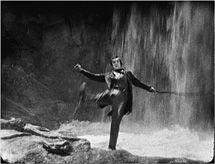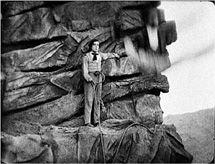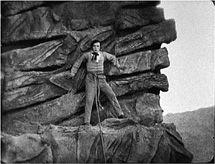B0041VYHGW EBOK (64 page)
Authors: David Bordwell,Kristin Thompson


4.171 The motif begins as Willie is jerked into the water.
Perhaps the single funniest shot in the film occurs when Willie realizes that since the Canfield boy has fallen off the rocks
(
4.172
),
so must he
(
4.173
).
But even after Willie gets free of Canfield, the rope remains tied around his waist. So in the film’s climax, Willie is dangling from a log over the waterfall
(
4.174
).
Here again, one element fulfills multiple functions. The fish-on-the-line device advances the narrative, becomes a motif unifying the film, and takes its place in a pattern of parallel gags involving variations of Willie on the rope. In such ways,
Our Hospitality
becomes an outstanding example of the integration of cinematic mise-en-scene with narrative form.

4.172 Tied to Willie, the Canfield boy falls off the cliff …

4.173 … and Willie braces himself to be pulled after.
The viewer who wants to study mise-en-scene should look for it systematically. We should watch, first of all, for how setting, costume, lighting, and the behavior of the figures present themselves in a given film. As a start, we might trace only one sort of element—say, setting or lighting—through a scene.
We should also reflect on the patterning of mise-en-scene elements. How do they function? How do they constitute motifs that weave their ways through the entire film? In addition, we should notice how mise-en-scene is patterned in space and time to attract and guide our attention through the process of watching the film and to create suspense or surprise.
Finally, we should try to relate the system of mise-en-scene to the large-scale form of the film. Hard-and-fast prejudices about realism are of less value here than an openness to the great variety of mise-en-scene possibilities. Awareness of those possibilities will better help us to determine the functions of mise-en-scene.
WHERE TO GO FROM HERE
As a concept, mise-en-scene dates back to the 19th-century theater. For a historical introduction that is relevant to film, see Oscar G. Brockett and Robert R. Findlay,
Century of Innovation
(Englewood Cliffs, NJ: Prentice-Hall, 1973). The standard film works are Nicolas Vardac,
Stage to Screen
(Cambridge, MA: Harvard University Press, 1949), and Ben Brewster and Lea Jacobs,
Theatre to Cinema: Stage Pictorialism and the Early Feature Film
(Oxford: Oxford University Press, 1997).
Many film theorists have seen film as a realistic medium par excellence. For such theorists as Siegfried Kracauer, André Bazin, and V. F. Perkins, cinema’s power lies in its ability to present a recognizable reality. The realist theorist thus often values authenticity in costume and setting, naturalistic acting, and unstylized lighting. “The primary function of decor,” writes Perkins, “is to provide a believable environment for the action” (
Film as Film
[Baltimore: Penguin, 1972],
p. 94
). Bazin praises the Italian neorealist films of the 1940s for “faithfulness to everyday life in the scenario, truth to his part in an actor” (
What Is Cinema?
vol. 2 [Berkeley: University of California Press, 1970],
p. 25
).
Though mise-en-scene is always a product of selection and choice, the realist theorist may value the filmmaker who creates a mise-en-scene that
appears
to be reality. Kracauer suggests that even apparently unrealistic song-and-dance numbers in a musical can seem impromptu (
Theory of Film
[New York: Oxford University Press, 1965]), and Bazin considers a fantasy film such as
The Red Balloon
realistic because here “what is imaginary on the screen has the spatial density of something real” (
What Is Cinema?
vol. 1 [Berkeley: University of California Press, 1966],
p. 48
).
These theorists set the filmmaker the task of representing some historical, social, or aesthetic reality through the selection and arrangement of mise-en-scene. Though this book postpones the consideration of this problem—it lies more strictly in the domain of film theory—the realist controversy is worth your examination. Christopher Williams, in
Realism and the Cinema
(London: Routledge & Kegan Paul, 1980), reviews many issues in the area.
Digital,
or
3D,
animation typically involves a few widely used programs, such as Maya for creating movement and Renderman for adding surface texture. Animators deal with specific needs of their projects by developing new software for such effects as fire, water, and moving foliage. The figures to be animated are created either by scanning every surface of a maquette (a detailed model, such as the dinosaur in
1.29
) or by using motion capture (“mocap”), filming actors or animals in neutrally colored costumes covered with dots, which are the only things visible to the camera. The dots are connected by lines to create a “wire-frame” moving image, and the computer gradually adds more detailed layers to build a textured, three-dimensional, moving figure. Backgrounds can also be created digitally, using matte-painting programs. For figure animation, see
The Art of Maya: An Introduction to 3D Computer Graphics,
3d ed. (Alameda, CA: Sybex, 2007), which includes a CD-ROM with introductory material.
For fiction feature films, 3D animation became viable with
digital compositing,
used for the T-1000 cyborg in
Terminator 2: Judgment Day.
Here a grid was painted on the actor’s body, and the actor was filmed executing movements. As the film was scanned, the changing grid patterns were translated into a digital code similar to that used on compact discs. Then new actions could be created on the computer frame by frame. For a discussion, see Jody Duncan, “A Once and Future War,”
Cinefex
47 (August 1991): 4–59. Since
Terminator 2,
sophisticated software programs have enabled directors to create “actors” wholly from models that can be scanned into a computer and then animated. The most famous early example is the gallimimus herd in
Jurassic Park.
The phases of the imaging process for this film are explained in Jody Duncan, “The Beauty in the Beasts,”
Cinefex
55 (August 1993): 42–95. Both analog image synthesis and digital compositing were used in
The Matrix;
for background, see Kevin H. Martin, “Jacking into the Matrix,”
Cinefex
79 (October 1999): 66–89. The rendering of realistic human and humanlike characters depended on finding a way to create the elusively translucent quality of skin. Such figures as Jar Jar Binks in
Star Wars Episode 1: The Phantom Menace
and especially Gollum in
The Lord of the Rings
finally achieved this goal. See
Cinefex
78 (July 1999), completely devoted to
The Phantom Menace;
Joe Fordham, “Middle-Earth Strikes Back,”
Cinefex
92 (January 2003): 70–142; and Joe Fordham, “Journey’s End,”
Cinefex
96 (January 2004): 55–142. Computer visual effects have become so common that any issue of
Cinefex
details the technology used in one or more recent films.
The combination of live-action filming with computer animation has created a fresh range of cinematic effects. Méliès’ urge to dazzle the audience with the magical powers of mise-en-scene continues to bear fruit.
On costume, see Elizabeth Lees,
Costume Design in the Movies
(London: BCW, 1976), and Edward Maeder, ed.,
Hollywood and History: Costume Design in Film
(New York: Thames & Hudson, 1987). See also Vincent J.-R. Kehoe,
The Technique of the Professional Make-Up Artist
(Boston: Focal Press, 1995).
Léon Barsacq, with careful assistance by Elliott Stein, has produced a wide-ranging history of setting,
Caligari’s Cabinet and Other Grand Illusions: A History of Film Design
(New York: New American Library, 1976). Other major studies of decor in the cinema are Charles Affron and Mirella Jona Affron,
Sets in Motion: Art Direction and Film Narrative
(New Brunswick, NJ: Rutgers University Press, 1995); Dietrich Meumann, ed.,
Film Architecture: Set Designs from “Metropolis” to “Blade Runner”
(Munich: Prestel, 1996); and C. S. Tashiro,
Pretty Pictures: Production Design and the History of Film
(Austin: University of Texas Press, 1998). For insightful interviews with set designers, see Vincent LoBrutto,
By Design
(New York: Praeger, 1992), and Peter Ettedgui,
Production Design & Art Direction
(Woburn, MA: Focal Press, 1999). An excellent overview is offered by Vincent LoBrutto in
The Filmmaker’s Guide to Production Design
(New York: Allworth, 2002). See also Peter Ettedgui,
Production Design and Art Direction
(Woburn, MA: Focal Press, 1999). Pascal Pinteau’s gorgeously illustrated
Special Effects: An Oral History
(New York: Abrams, 2003) covers not only models and digital effects but also make-up, setting, and even theme park rides.
A wide-ranging analysis of performance in film is Richard Dyer,
Stars
(London: British Film Institute, 1979). This book is complemented by Charles Affron,
Star Acting: Gish, Garbo, Davis
(New York: Dutton, 1977), and James Naremore,
Acting in the Cinema
(Berkeley: University of California Press, 1988). Useful practical guides are Patrick Tucker,
Secrets of Screen Acting
(New York: Routledge, 1994), and Tony Barr,
Acting for the Camera
(New York: Perennial, 1986). The ways in which a performance can be integrated with a film’s overall form are considered in two other manuals:
The Film Director’s Intuition: Script Analysis and Rehearsal Techniques,
by Judith Wilson (Studio City, CA: Michael Wiese, 2003), and Delia Salvi’s
Friendly Enemies: Maximizing the Director–Actor Relationship
(New York: Billboard, 2003). Staging techniques in theater are comprehensively explained in Terry John Converse’s
Directing for the Stage
(Colorado Springs: Meriwether, 2005). Michael Caine’s
Acting in Film: An Actor’s Take on Movie Making
(New York: Applause Books) offers excellent and detailed discussion; see also the accompanying video,
Michael Caine on Acting in Film.
Two fine surveys of lighting are Kris Malkiewicz,
Film Lighting: Talks with Hollywood’s Cinematographers and Gaffers
(New York: Prentice-Hall, 1986), and Gerald Millerson,
Lighting for Television & Film,
3d ed. (Boston: Focal Press, 1999). John Alton’s
Painting with Light
(New York: Macmillan, 1949) and Gerald Millerson’s
Technique of Lighting for Television and Motion Pictures
(New York: Hastings House, 1972) are useful older discussions, with emphasis on classical Hollywood practices. See also John Jackman,
Lighting for Digital Video and Television,
2d. ed. (San Francisco: CMP, 2004). A useful reference book is Richard K. Ferncase’s
Film and Video Lighting Terms and Concepts
(Newton, MA: Focal Press, 1995).
Art historians have long studied how a two-dimensional image can be made to suggest a deep space. A comprehensive introductory survey is William V. Dunning,
Changing Images of Pictorial Space: A History of Spatial Illusion in Painting
(Syracuse: Syracuse University Press, 1991). Dunning’s history of Western painting emphasizes the manipulation of five techniques we have considered in this chapter: linear perspective, shading, the separation of planes, atmospheric perspective, and color perspective.
Though film directors have of course manipulated the image’s depth and flatness since the beginning of cinema, critical understanding of these spatial qualities did not emerge until the 1940s. It was then that André Bazin called attention to the fact that certain directors staged their shots in unusually deep space. Bazin singled out F. W. Murnau (for
Nosferatu
and
Sunrise
), Orson Welles (for
Citizen Kane
and
The Magnificent Ambersons
), William Wyler (for
The Little Foxes
and
The Best Years of Our Lives
), and Jean Renoir (for practically all of his 1930s work). By offering us depth and flatness as analytical categories, Bazin increased our understanding of mise-en-scene. (See “The Evolution of the Language of Cinema,” in
What Is Cinema?
vol. 1.) Interestingly, Sergei Eisenstein, who is often contrasted with Bazin, explicitly discussed principles of deep-space staging in the 1930s, as recorded by his faithful pupil, Vladimir Nizhny, in
Lessons with Eisenstein
(New York: Hill & Wang, 1962). Eisenstein asked his class to stage a murder scene in a single shot and without camera movement; the result was a startling use of extreme depth and dynamic movement toward the spectator. For a discussion, see David Bordwell,
The Cinema of Eisenstein
(Cambridge, MA: Harvard University Press, 1993),
chaps. 4
and
6
. For a general historical overview of depth in mise-en-scene, see David Bordwell’s
On the History of Film Style
(Cambridge, MA: Harvard University Press, 1997),
chap. 6
.
Two clear and readable discussions of color aesthetics in general are Luigina De Grandis,
Theory and Use of Color,
trans. John Gilbert (New York: Abrams, 1986), and Paul Zelanski and Mary Pat Fisher,
Colour for Designers and Artists
(London: Herbert Press, 1989).
For general discussion of the aesthetics of film color, see Raymond Durgnat, “Colours and Contrasts,”
Films and Filming
15, 2 (November 1968): 58–62; and William Johnson, “Coming to Terms with Color,”
Film Quarterly
20, 1 (Fall 1966): 2–22. The most detailed analysis of color organization in films is Scott Higgins,
Harnessing the Rainbow: Technicolor Design in the 1930s
(Austin: University of Texas Press, 2006).
The film shot is like the painter’s canvas: it must be filled up, and the spectator must be cued to notice certain things (and not to notice others). For this reason, composition in film owes much to principles developed in the graphic arts. A good basic study of composition is Donald L. Weismann,
The Visual Arts as Human Experience
(Englewood Cliffs, NJ: Prentice-Hall, 1974), which has many interesting things to say about depth as well. More elaborate discussions are to be found in Rudolf Arnheim,
Art and Visual Perception: A Psychology of the Creative Eye,
rev. ed. (Berkeley: University of California Press, 1974), and his
The Power of the Center: A Study of Composition in the Visual Arts,
2d ed. (Berkeley: University of California Press, 1988). See also Peter Ward,
Picture Composition for Film and Television
(London: Focal Press, 1996).
